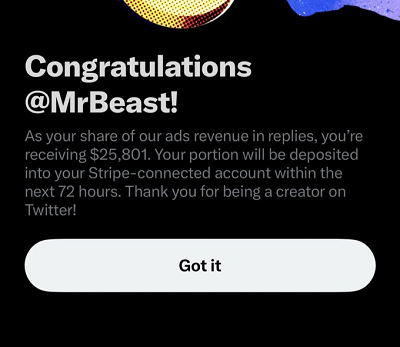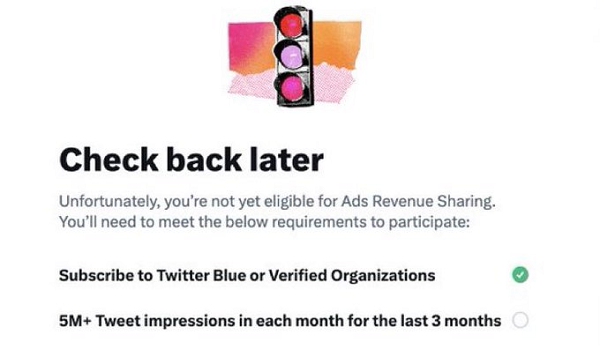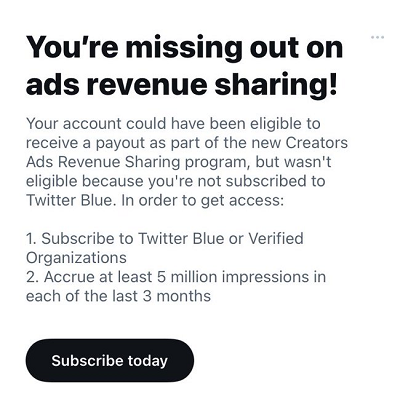Can you really make a living by simply tweeting your thoughts on the latest hot topics?
That’s why your trusted partners at Yaccarino and Musk are trying to suggest, with a range of high-profile Twitter users this week sharing their big payouts from the first round of Twitter’s ad revenue share program, which enables creators to profit from ads shown (to verified users) within their tweet replies.

Indeed, some tweeters have generated five, even six figure sums from the program – but before you go quitting your day job to start crafting clever tweets, it’s worth noting that there are some fairly significant provisos in Twitter’s new incentive scheme.
First off, Twitter’s ad revenue share program is only available to Twitter Blue subscribers, so you have to pay $8 a month to be eligible in the first place. Which is obviously not a significant barrier, especially when you’re going to be taking in thousands from your tweets, while you also need a Stripe account, at present, to facilitate payment.
Easy so far, now here comes the tougher element – you also need to average 5m tweet impressions per month over a three-month span, at least.

That’s a lot. Most users aren’t seeing anywhere close to that level of response, which significantly limits who can actually monetize their content.
There’s also then a question of scale, and the viability of Twitter delivering big payouts from the program ongoing. For this first payment, Twitter owner Elon Musk says that the total sum being paid equates to $5 million, covering a five-month period back to February, when he first announced the revenue share scheme.
In a few weeks, X/Twitter will start paying creators for ads served in their replies. First block payment totals $5M.
Note, the creator must be verified and only ads served to verified users count.
— Elon Musk (@elonmusk) June 9, 2023
So while these initial payments are high, you actually need to divide each by five to get the monthly payment totals, with the block payment giving an inflated view of what you can expect.
To get some perspective on what sort of payment you really might see, you need to break down the numbers a bit further.
Looking at the payouts that have been reported via tweet, with many program participants sharing their figures, more than 9% of the total $5 million payout has gone to just 40 creators. As noted, some of these creators have reported getting $20k, $25k, even $100k in the case of @InterenetHOF (which reposts popular content from across the web). But even taking all of these big payments into account, the average payout among these high-engagement profiles is $2,275 per month. Take out the top 4 earners in the list, and that drops to $1,500 a month – so while the big numbers being shared may be dazzling, you’re unlikely to be able to quit your day job based on this program alone.
Which, of course, Twitter’s not saying that you can – this is one component of its broader creator monetization push, which also includes subscriptions, and more to come. But it is worth noting that the reality of generating income from ads in tweet replies is very, very unlikely to see you pulling in $100k payments, as some have in this first set.
As The Washington Post has also reported, many of the top earners thus far have also been right-leaning political commentators – which makes sense, as these are the users that are signing up to Twitter Blue, while a lot of the big winners are also aligned to Elon himself, including a range of Tesla fan accounts.
As a result, some have suggested that this is just Elon paying his friends, and without transparency, we have no way of knowing the full workings of the process. But Twitter maintains that the program is open to all who meet the stated requirements, and live in a region where Twitter payments are available.
Indeed, Twitter has also been using these big initial payouts as a lure for more creators, by sending out this notification to other big accounts.

Note the use of ‘could’ in the first sentence – as we reported last week, the delayed payments, leading to bigger totals, and the timing of the release has made this the perfect counter to the sudden attention that Meta’s Threads app is getting, by showing users that they could actually make money from their tweets, and big money at that, if they stay with Twitter instead.
But ‘could’ is important. Many big accounts were not eligible for the program, even some of those that met the high engagement markers, though Twitter has also noted that it is expanding eligibility soon.
The next question, then, is long-term viability. With Twitter’s ad revenue still down by 50% year-over-year, that leaves a slimmer pool to draw from for creator revenue share, which means that as more people sign up, it’ll get even harder for Twitter to keep offering the same levels of payouts, unless it can lure more ad partners. At some stage, that will also come to a head, and if Twitter can’t bring in more ad revenue, you can bet that the creator cut from ads in replies will be reduced, diluting the amounts paid to all creators.
That’s the next big risk. Snapchat, for example, suffered significant backlash after more creators sought to take part in its Spotlight rewards program, which saw creators allocated a percentage of a static fund based on the performance of their clips.
As more creators signed up, the payment totals shrunk – so while creators were actually generating more engagement over time, the money they saw, as a result, was declining each cycle.
If Twitter’s forced to reduce its payment amounts, you can expect to see similar response, especially as creators become more reliant on that income.
Essentially, it’s very early days for the program as yet, and if Twitter can’t get more ad dollars coming in, it’s hard to see how this program scales accordingly, as more users seek to boost their Twitter engagement for a share of the cash.
And unless you’re seeing, or are likely to see millions of tweet impressions per month, it may not even worth signing up – and even then, with an average payout of $350 per week for the top most active accounts, the amount of time and effort that you’ll need to put in to reach these numbers may not be worth it, especially as Twitter looks to crack down on those who just reshare popular content from across the web.
The end result, as I see it, will be a lot more people posting a lot more incendiary tweets, in the hopes of sparking more engagement. Anger is the emotion that sparks the most comments on web content, and as such, that’s likely how users are going to look to find a way into this program.
More divisive content is conversely unlikely to attract more ad spend. And if advertisers don’t want their ads to appear in reply threads, that reduces the amount of revenue to share – so it may not be the gold mine that these big early payouts suggest.
But wait, there’s more – Elon has also said that, soon, the payouts from Twitter’s ad revenue share will ‘roughly double’ when they add in share from profile page views as well.
As promised.
Soon, we will share ad revenue from profile page views, which should roughly double payouts.
Note, only views from verified users count, as it is otherwise trivial to bot scam the view count.
— Elon Musk (@elonmusk) July 16, 2023
I’m not sure how accurate that estimation is, as most users spend the majority of their Twitter time in the main feed. But it adds another consideration to the mix, which could help to lure more creators.



